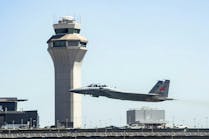Feb. 19—KABUL, Afghanistan — The Afghan air force, a key factor in the government's ability to keep Taliban insurgents at bay, won't be able to fly effective combat missions within months if the few remaining allied advisers leave, a new report said.
Almost 94% of NATO's Train Advise Assist Command-Air personnel, tasked with helping build Afghanistan's air force, have already left the country over the last nine months, a report to Congress by the Lead Inspector General for Operation Freedom's Sentinel said.
The sharp drawdown of foreign military advisers, mainly from the U.S., has virtually paralyzed the mission to train crews and maintain the service's aircraft, it said.
If U.S. forces leave Afghanistan by the May 1 deadline outlined in last year's deal with the Taliban, the Afghan air force will have to maintain its aircraft and facilities on its own.
But the service is still "completely dependent" on expensive U.S. contractors, who are also supposed to depart as part of the deal.
Without this support, "no airframe can be sustained as combat effective for more than a few months," the report said.
The strains of reduced manpower have left the command's mission "largely static," with less advising and oversight, the report released Wednesday said. "Lost training time, lack of U.S. military evaluators to assess proficiency, and reduced advisor oversight have (led to a) decline in basic skills for aircrews and maintainers," it said.
TAAC-Air said it is trying to figure out how it will train personnel and maintain equipment during the drawdown. Dwindling staffing and the coronavirus pandemic prevented most face-to-face meetings between U.S. advisers and Afghan airmen, the command said in the report.
The reduced U.S. military footprint has meant almost total reliance on contractors to train airmen, with fewer personnel to check on them.
"It has been difficult to hold contractors accountable," the command said.
Afghan ground forces depend heavily on strike aircraft and helicopters to respond quickly to guerrilla attacks on isolated outposts, and to ferry troops and supplies. They are also crucial for the evacuation of casualties in a country with a poor road infrastructure.
The increasing demands on the air force have strained the service, which has lost almost a quarter of the operational aircraft in its inventory over the past year, the report said.
Three separate collisions destroyed five aircraft and damaged one, with others undergoing maintenance.
The nation's few pilots and crew members are also overextended, flying excessive hours on missions often above their experience level, it said.
Finding replacements for these pilots could prove difficult, as the drawdown led to the end of contracts to train MD-530 and UH-60 air crews. The training program for the A-29 program may be next on the chopping block, the report said.
"Further drawdown and the associated closure of bases will effectively end all in-country aviation training contracts in Afghanistan," it said.
Twitter: @jplawrence3
___
(c)2021 the Stars and Stripes
Visit the Stars and Stripes at www.stripes.com
Distributed by Tribune Content Agency, LLC.


